January 2009 archives
you are here [x]: Scarlet Star Studios > the Scarlet Letters > January 2009
<< before
December 2008
after >>
February 2009
January 31, 2009
birthday card: kristen dideaux
by sven at 7:00 am
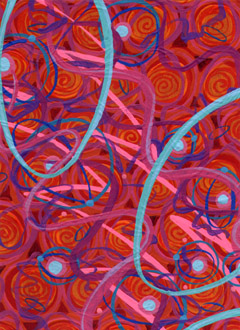
Today is Captain K's birthday...
From Notorious Sven & Nefarious Gretchin: happy birthday!
posted by sven | permalink | categories: painting
January 29, 2009
prep for playwriting class
by sven at 12:08 pm
I'm going to be taking an 8-week playwriting class starting Saturday. It sounded like fun -- and I want to put myself in a context that forces me to put what I've been reading about into practice.
Why Playwriting Is Relevant To Stopmoes
I view all creative fiction as related: the novel, the short story, the film script, the stage play. However, I think playwriting may be what is most relevant to creating stopmo scripts. Unlike novels and short stories, scripts for plays prohibit writing internal thought. Everything has to be visible action.
Playwriting also has a focus that I believe will speak to my particular weaknesses as a fantasist. There is an emphasis on the construction of "character" and what creates good "drama" that is not discussed so pointedly in the other realms of writing.
I could also point to the tendency of stage plays to have a limited number of sets and characters -- which is useful to the stopmoe who can't afford to fabricate "a cast of thousands." (Though this actually has more to do with the budgets of modern theaters than inherent limits of the form.)
The Best Stuff I've Learned About Playwriting Lately
In preparation for the class, I've been feverishly reviewing and digesting everything I've learned during the last year about story construction. I'm going to haphazardly throw out a few of the best concepts I've gleaned:
1) The "iceberg" principle
Only 10% of the world that you create is going to appear on stage. Explore the backstory of your characters fully. Then, when you frame a portion of their storyline on stage, it is sure to be rich with subtext and detail. Give yourself permission to generate far more material than you need -- then you can select the best bits to share.
2) The "treatment"
Before you write a story, describe what you're going to write in summary form. Describing what you roughly imagine is going to happen makes the process of writing the real script far easier. Recognize that just as you may do several storyboards at varying levels of polish (thumbnail storyboard, polished storyboard, "storyreel" slideshow, 2D animatic with moving elements), so too you can write several varieties of treatment: an explanation of the key elements that make your story worth telling; a summary of your world's history; a summary of what occurs in the story frame; detailed summaries of what you want to happen in each scene.
3) 1000 question marks
Treatments are a form of summary for material you've already generated. The best way to generate new material is to start writing down questions. Try putting a question mark at the end of every sentence. Even when you propose an answer to one of your questions, frame it as a question, thus encouraging yourself to throw out additional possible answers. The most important thing is to keep typing non-stop -- don't pause! The work goes quickly, and excites the imagination. Use the "search" function on your word processor to look for question marks. If you haven't hit 1000 yet, it's unlikely that you've imagined and explored your story world deeply enough.
4) Auxiliary documents
The primary work of creating a story is accomplished by the "1000 question marks" method. As you create possibilities, you'll naturally begin seeing bits coming out that you like and want to keep. Develop a personal list of documents (in addition to the treatments) that you hope you'll have adequate information for by the end of the generation phase. These might include:
- list of the character's top 7 major life events
- character's life timeline
- character dossier of personal information
- what does the character want? (at all levels of their being)
- character's different social roles within his/her environment
- description of the character's relationship with each of the other characters in your cast
- the fictional world's backstory
- the world's timeline
- physical/historical descriptions of the most important locations in the story world
- a list of all possible character pairings (which then suggests scenes)
- a list of your scenes in ascending order of tension
5) Personal vocabulary of images
Most of the work of writing boils down to this: identify all possible options, select your favorites, develop a logic that can successfully connect your best elements. However, this process doesn't address the fundamental issue of where to find ideas that you care about. Just as I advocate working from "rough to polished," there's an argument for working from "illogic to logic." Discover material that excites you not through brute intellect, but by intuitive emotion that is focussed on randomized inspirational materials. There are several ways to accomplish this. Collaging: Go through magazines as fast as you can, tearing out images that you find appealing -- without regard to why you're attracted to them; turn them into a collage -- now do stream-of-consciousness writing about what your juxtaposed images bring to mind; underline the bits of your writing that seem exciting. Memory: Gather a bowl of writing prompts (several books have lists); do stream-of-consciousness writing, proceed as described in the last method. (There are several more similar approaches.)
[Star Wars is held up as the quintessential expression of Joseph Campbell's "Hero's Journey" pattern... That's true -- but try looking at it as a collage instead: Lucas stitched together Tarzan, Errol Flynn sword fights, WWII dogfights, Kurosawa's "The Hidden Fortress." He found key images that spoke to him, which helped give the story its soul.]
6) Proof as you develop
As you develop germs of ideas into fleshed out story worlds, keep a check-list similar to this one at hand... As you work, make certain that all of these necessities are ultimately being satisfied.
- Does your story have a conflict?
- Does your story have any one focal character?
- Who is the focal character of the story?
- Is the POV character different from the main character?
- Has the main/POV character received deep characterization?
- What does your character desperately want/need in life?
- What is the main problem/conflict of the story?
- Does the problem/conflict confirm the centrality of the main character?
- When does the conflict/problem become apparent in your storyline?
- Does the start of the story clearly establish what the problem/conflict is?
- Does the resolution of the story answer the same problem/conflict established at the beginning?
7) Conflict is over physical objects of symbolic significance
Every scene is structured around a conflict. Characters seldom address conflict openly. Meaning is invested into objects, which the characters battle over. (Every scene has a "mcguffin.") Understand the deep yearnings of your story people -- but then look for how it's expressed in terms of props or even people that they want to possess.
[Try analyzing Star Wars in terms of how each scene is an argument about a mcguffin. (a) Vader to Leia: Where are those plans? (b) C3PO to R2D2: I reject your route (it's much too rocky). (c) Luke to Uncle Owen: I want to go get power converters. (d) Ben to Luke: I want you to come with me to Alderaan... Which is resolved by killing off Owen and Beru. (f) Ben to Han: I want use of your ship. ...etc.]
posted by sven | permalink | categories: writing
January 28, 2009
lsgl: the story revealed
by sven at 12:01 am
Last year I spent about 170 pages exploring the backstory of Let Sleeping Gods Lie. I feel very good about that work. Before, I was floundering because all I really had was visuals -- I didn't have my story's logic nailed down.
This year I've come to realize that LSGL is no longer an adaptation of At The Mountains of Madness. Rather, what I've done is to create an entirely new story that exists at the intersection of ATMOM and The Shadow Out of Time.
Nothing I've created contradicts Lovecraft's novellas, I believe... But I've taken great liberties in filling in gaps, extrapolating, and contributing new material to the mythos.
Here's an abridged version of the whole shebang. [Spoiler alert!]
1. The origin and tragic demise of the Elders
The Elders came to Earth before there was life here. They used their own blood to create the first species: the giant protoplasmic blobs known as Shoggoths. It is from the Shoggoths that all other species evolved.
The Elders fought several wars with extraterrestrials. During the wars they made the Shoggoths larger, stronger, and more intelligent. At the point of giving Shoggoths intelligence, the blobs were no longer merely biological machines. They became the Elders' slaves.
The Elders' society slowly decayed, and ultimately retreated into geothermally heated caves in the Antarctic. Shoggoth slaves living in the city were able to discover great numbers of runaway Shoggoths living on the ocean floor. The runaways were organized for rebellion.
In one cataclysmic day -- about 50,000 years ago -- the Elders were wiped out. The Shoggoth army combined into a tidal wave that broke through the cave walls and smashed the last underground city.
2. The origin and ultimate escape of the Yith
The Yith are a species that is able to travel through time by telepathically switching minds with other beings. They lived on Earth approximately 200 million years ago... And then, foreseeing their own demise, transferred their minds forward to a species of intelligent beetles that will come after humankind.
Abducted minds are treated as guests in Yithian society, and are able to learn a great deal -- before eventually being sent back to their own bodies with their minds wiped.
It is known that the Yith abducted the mind of at least one Elder: S'gg'ha, the oldest and greatest of the Elders' telepaths.
3. The Elder-Yith connection
Elders have 5-lobed brains. Each creature has five inter-linking, semi-autonomous personalities -- rather like a five-faced Hindu god that has conversations with itself.
When S'gg'ha was abducted, one personality was left behind and was able to mentally spy on the Yith abductor. When the greater part of the Elder's personality returned to its body, the fifth mind was able to help recover memories from 200 million years ago.
Thus it was discovered that some cataclysm awaited the Elders in the future. S'gg'ha began preparations to help save some portion of its people from the coming apocalypse.
4. The secret of the Elders' doomsday cult
Elders eschew all technology. However, S'gg'ha learned the secret to making the telepathic amplifiers that enable Yithian time travel. The Elder secretly began construction of such a machine beneath the Mountains of Madness -- the one place on Earth that its people feared.
[That's another story: about primordial forces that have existed beneath the mountains since even before the Elders' arrival, with whom S'gg'ha communed during the desperate war against Cthulhu's spawn.]
S'gg'ha kept the work secret even from itself, traveling backwards in time and telepathically seducing its best students to travel to the cave. When at long last the future self contacted the past self and it journeyed to the secret cave, it discovered several hundred followers there waiting.
Prior to the Shoggoths' final destruction of the Elders, this doomsday cult used the great telepathic amplifier to travel to another planet in the distant future. The minds that they displaced became imprisoned in their bodies back on Earth. However, the one-fifth minds that stayed behind here were able to keep these other future minds prisoners -- trapped with them inside the Elders' own hibernating bodies.
And so the cult avoided destruction; it remains in the secret cave to this day. The Elders sleep, sharing a collective dream...
Yet, the one-fifth minds telepathically heard the death cries of their society when the Shoggoths fell upon the underground city. Together they contemplate the massacre grimly, but believe themselves to be safe in this place that Shoggoths would never think to search.
5. Where LSGL begins
Enter the humans. Two explorers, Carl and Andrew, pick up strange distortion on their airplane's radio. They land, discover a cave. Wending their way into its depths, they find the doomsday cult.
They hear whispers in their minds coming from the dreamers. Hypnotically, they're drawn to the telepathic amplifier. Carl touches the machine and his mind glimpses the collective dream. In a language of symbols, he sees the creation of the first Shoggoth, the height of Elder civilization, and the final genocide.
The human mind is an intelligence not entirely dissimilar to the Elders' minds, and so it is able to engage with the machine. However, human biology is still derivative of the Shoggoths. When the machine and the dreamers recognize the Shoggoth taint, Carl is ejected from the dream and an emergency wake-up signal is sent to the Elders...
The four-fifths minds in the future are yanked back to the present and redeposited into their own bodies.
6. Where LSGL ends
Unfortunately for the sleeping gods, the human mind acts as a telepathic transducer. The wake-up call is translated into a message understandable by any being, which goes out in all directions. The great Shoggoth hunters who have sworn vengeance against their former masters till the end of time are alerted. Humans, great grandchildren of the Elders, have unwittingly betrayed their creators.
As the explorers attempt to depart the cave, they are confronted by a colossal shoggoth blocking the only exit. The Elders, just waking now, stampede in an attempt to escape -- but there's nowhere to go.
Andrew is knocked down and dies in the chaos. Carl is absorbed by the Shoggoth, and his cellular material reverts to it's original protoplasmic nature. His ruined body begins to sprout tentacle-like pseudopods.
As he loses consciousness, he reenters the dream and receives one final revelatory vision: he sees the Elders shaping Shoggoth matter into the first human form. He comes to understand our species' relationship to the horrible, gelatinous, ex-slaves... "We are brothers."
posted by sven | permalink | categories: let sleeping gods lie
January 27, 2009
birthday card: chloe wicklund
by sven at 7:00 am
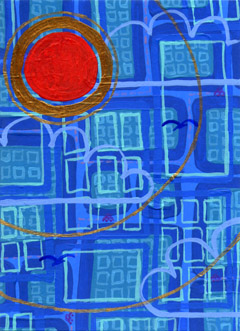
Today is Chloe's birthday...
From Sven & Gretchin: happy birthday!
Look for the little purple cars. ;-)
posted by sven | permalink | categories: painting
January 20, 2009
birthday card: justin rasch
by sven at 7:00 am
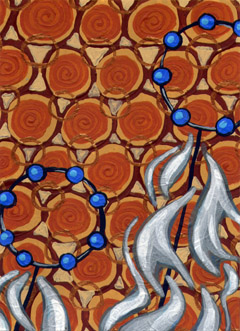
Today is Justin's birthday...
From Scarlet Star Studios: happy birthday Justin!
And congratulations on premiering Gerald's Last Day!
posted by sven | permalink | categories: painting
January 19, 2009
a theater-based approach to stopmo
by sven at 5:42 pm
During the past year I've been studying how to write novels and plays, how to direct theatrical productions, and different schools of acting... All with the intent to apply what I learn to stopmo. Here are some guiding principles of the approach I've been working out:
A Theater-Based Approach to Stopmo
The filmmaking process is to "develop material through improvisation." This is different from "planning in advance" in that there is an emphasis on working out a final version through successive iterations -- and on finding solutions to problems through creative play.
Practice animating generic puppet "actors" in "black box theater" sets. Try viewing them as your "acting ensemble."
View specially sculpted and cast puppet heads/bodies as "masks" and "costumes."
Practice animating lipsync, blocking, and gestures by using Shakespeare and other play scripts that have entered the public domain.
With original stories, explore all aspects of the story line before drafting a script. Remember: the script frames only a small part of your story world and its timeline.
Work out the story logic in writing prior to creating visual storyboards. It's easier to discover where things don't make sense when you're forced to actually explain why your characters are doing whatever they're doing.
Work "from rough to polished" in developing your shot list. Suggested stages: (a) thumbnail storyboard, (b) post-it storyboard, (c) polished storyboard, (d) story reel [slideshow], (e) 2D animatic [moving 2D elements], (f) photo animatic, (g) pop-thru.
Proof your story via 2D animatic prior to fabricating non-generic puppets and/or sets. No matter how simple you think your film is, it will take far less time to preview what your story is going to look like by using drawings than to construct and and film it in 3D. (Compare this to how actors do a "read-through" and a "walkthrough" when producing a play.)
Voice track dictates animation; it sets the timing.
Proof your gestures & lipsyncs using pop-thrus and sequenced sets of headshots. (Compare this to doing rehearsals for a play.)
Proof lipsync separately from gestures/blocking. ...And be sure to double-check the viseme analysis when you have the final puppet "mask" with its particular set of mouth shapes.
Strive to create puppet characters that have unique personalities -- not enigmatic anonymity.
To understand a puppet character: Get their voice in your head by writing first-person narratives from their POV. Explore their posture, habitual gestures, style of walk, and way of doing simple activities by acting these things out with your own body.
Do not rely on "costume" as the primary indicator of character.
Make many quick clay "sketches" (maquettes) when developing character "costumes." Ceramic clay is the 3D equivalent of the pencil: it's the fastest and cheapest way to rough out ideas.
Do the final character sculpt prior to making the puppet's armature. Use a throw-away wire armature for building the sculpt.
When animating a performance, work pose-to-pose. Use the pop-thru "rehearsal" as reference.
posted by sven | permalink | categories: stopmo
January 15, 2009
lsgl: animatic for act 2 bridge
by sven at 2:40 pm
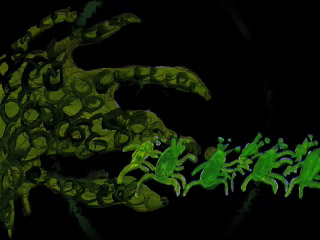
Here's the 2D animatic I roughed out for the new bridge in Act 2.
Most of the images were made with green colored pencil on 3"x4" black cardstock. The shoggoth was painted in acrylic on a white card.
Storyboard frames made in this fashion are very appealing! Next time I do a full film, I think I'll go through the trouble of translating thumbnail drawings into little paintings. Much more evocative.
Next steps: I've taken still shots from this animatic and turned them into 2"x1.5" jpgs. In Microsoft Word I've created vertical strips of photos which I'm now printing out and taping up on my foamcore storyboard workspace.

The idea is that with certain sequences locked into place, I ought to be able to fiddle around with where to insert new shots using post-it notes... But without having to rearrange the entire board every time.
["Story strips" and "photo storyboards" are two more ways of developing sequences that I didn't talk about in my last post.]
posted by sven | permalink | categories: let sleeping gods lie
January 13, 2009
birthday cards: violet & steve bell
by sven at 7:00 am
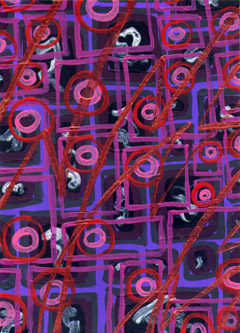
Today is Violet's birthday...
From me and Gretchin: happy birthday!
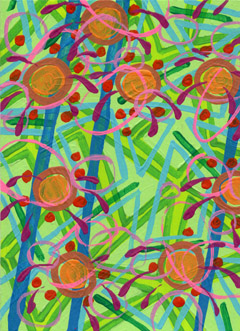
Violet's dad, Steve, also just had his birthday...
Only a little belatedly: happy birthday Steve!
posted by sven | permalink | categories: painting
January 11, 2009
lsgl: nailing down the animatic
by sven at 4:05 pm
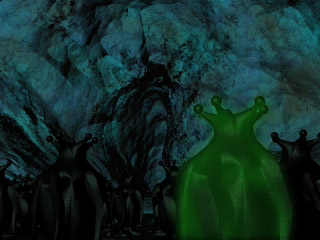
Here's a clip from my last work session, where I was roughing out what it might look like when the Elders' minds return to their hibernating bodies. There'll be some finessing of the FX, but the basic concept is there.
Now imagine a wave passing through the room, quickly rousing each Elder in succession. Heh.
As I get moving into 2009, I'm still taking stock of where the project stands.
In 2008 I wrote 170 pages of story development. I've got the story line nailed -- which is something I did NOT have in 2007.
For a filmic treatment, the story line has to be translated into visuals. I've got a lot of material posted on my storyboards -- but I'm realizing that before I move on to producing any polished shots, I really have to get the animatic nailed down.
If it takes until the end of January -- maybe even the end of February -- it'll be time well spent. I'm not worried much anymore about how to create my shots: all my props and the most important animation cycles are already created. What gives me searing headaches is not knowing exactly what shots I need in order to make a coherent sequence.
Normally creating sequences isn't that big a deal. But see, I had to go and write a script that involves a stampede. Getting one shot to flow into the next when there's so much going on at the same time has been a nightmare.
At this point in time, I still need to have my "inventive" hat on. I can't be pretending that I have a reliable roadmap to follow -- because I don't. I'm trying to follow the principle of "roughing out" ideas as quickly as possible, testing them with successively complicated iterations. Here's what that might look like:
- thumbnail storyboard - a bunch of tiny sketches of shots all on one sheet of paper
- post-it storyboard - thumbnails get photocopied and taped to post-it notes, so I can move them around on a big piece of foam core and see different possible sequences
- polished storyboard - cut a bunch of 3x5" cards to 3:4 ratio (a "full screen" TV's aspect ratio), draw the storyboard images more carefully in the given frame
- story reel - scan the polished storyboard frames, create a "slideshow" of the sequence
- 2D animatic - using PhotoShop and AfterEffects, separate the static characters from their backgrounds and create a new test film with limited motion
- 3D animatic - using low-res CG stand-ins, recreate the 2D animatic in a simulated 3D space
Sounds logical, eh? Well, film-making's never really that linear. You think you've got your "pre-visualization" all set... And then you discover a hole. So you go back, make new material, cut and paste...
Here's one new-to-me thought that I've been exploring: We usually talk about "the storyboard" as if a film has just one. Particularly when I'm in the post-it storyboard phase, I'm finding that I'm creating a variety of possible sequences -- and I'm unable to keep them all in my head so I can compare them...
So I'm thinking now that I want to experiment with "story strips": printing out multiple copies of storyboard frames and taping them into long vertical strips which I can hang side-by-side. That way (in theory) I ought to be able to put together a couple of different options for how to edit a scene -- and not forget mid-process what my previous ideas looked like.
Being able to compare options is important.
P.S. Can anyone point me to some tutorials on setting gamma? The level of darkness in my frames varies radically between software applications, and I'm worried about not having control over the final output.
posted by sven | permalink | categories: let sleeping gods lie
January 9, 2009
birthday card: grant goans
by sven at 7:00 am
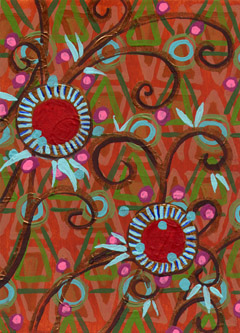
Today is Grant's birthday...
From Scarlet Star Studios: happy birthday Grant!
posted by sven | permalink | categories: painting
January 6, 2009
2009 lsgl work begins
by sven at 4:54 pm
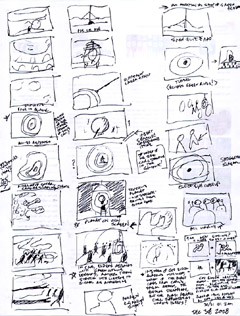
I marked it on my calendar: on January 6, get back to work on "Let Sleeping Gods Lie." So here goes...
May 2009 be the year I get this film done!
I'm hopeful. On the last day of 2008 -- at 2am -- I was visited by my muse. I got out of bed and scribbled out a thumbnail storyboard: a short new bridge in Act II, a different transition to Act III, and a single shot that creates an entirely new ending for the film.
The changes don't require any new props. And it feels like the story will make somewhat more sense now.
Anyway, I'll start developing the new storyboard and see where it leads.
posted by sven | permalink | categories: let sleeping gods lie